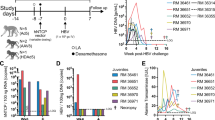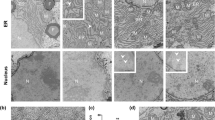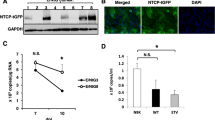Abstract
Persistence of hepatocytes transplanted into the same or related species has been established1,2,3,4,5,6,7,8. The long-term engraftment of human hepatocytes into rodents would be useful for the study of human viral hepatitis, where it might allow the species, technical and size limitations of the current animal models to be overcome. Although transgenic mice expressing the hepatitis B virus (HBV) genome produce infectious virus in their serum, the viral life cycle is not complete, in that the early stages of viral binding and entry into hepatocytes and production of an episomal transcriptional DNA template do not occur9,10. As for hepatitis delta virus (HDV), another cause of liver disease11,12, no effective therapy exists to eradicate infection, and it remains resistant even to recent regimens that have considerably changed the treatment of HBV (ref. 13). Here, we demonstrate long-term engraftment of primary human hepatocytes transplanted in a matrix under the kidney capsule of mice with administration of an agonistic antibody against c-Met. These mice were susceptible to HBV infection and completion of the viral life cycle. In addition, we demonstrate super-infection of the HBV-infected mice with HDV. Our results describe a new xenotransplant model that allows study of multiple aspects of human hepatitis viral infections, and may enhance studies of human liver diseases.
This is a preview of subscription content, access via your institution
Access options
Subscribe to this journal
Receive 12 print issues and online access
$259.00 per year
only $21.58 per issue
Buy this article
- Purchase on SpringerLink
- Instant access to full article PDF
Prices may be subject to local taxes which are calculated during checkout




Similar content being viewed by others
References
Fox, I.J. et al. Treatment of the Crigler-Najjar syndrome type I with hepatocyte transplantation. N. Engl. J. Med. 338, 1422–1426 (1998).
Gupta, S., Rajvanshi, P. & Lee, C.D. Integration of transplanted hepatocytes into host liver plates demonstrated with dipeptidyl peptidase IV-deficient rats. Proc. Natl. Acad. Sci. USA 92, 5860–5864 (1995).
Overturf, K. et al. Hepatocytes corrected by gene therapy are selected in vivo in a murine model of hereditary tyrosinaemia type I. Nature Genet. 12, 266–273 (1996).
Ponder, K. et al. Mouse hepatocytes migrate to liver parenchyma and function indefinitely after intrasplenic transplantation. Proc. Natl. Acad. Sci. USA 88, 1217–1221 (1991).
Rhim, J.A., Sandgren, E.P., Degen, J.L., Palmiter, R.D. & Brinster, R.L. Replacement of diseased mouse liver by hepatic cell transplantation. Science 263, 1149–1152 (1994).
Sandgren, E.P. et al. Complete hepatic regeneration after somatic deletion of an albumin-plasminogen activator transgene. Cell 66, 245–256 (1991).
Vrancken Peeters, M.T.F.D., Patijn, G.A., Lieber, A., Perkins, J. & Kay, M.A. Expansion of donor hepatocytes after recombinant adenovirus-induced liver regeneration in mice. Hepatology 25, 884–888 (1997).
Petersen, J., Dandri, M., Gupta, S. & Rogler, C.E. Liver repopulation with xenogenic hepatocytes in B and T cell-deficient mice leads to chronic hepadnavirus infection and clonal growth of hepatocellular carcinoma. Proc. Natl. Acad. Sci. USA 95, 310–315 (1998).
Araki, K. et al. Expression and replication of hepatitis B virus genome in transgenic mice. Proc. Natl. Acad. Sci. USA 86, 207–211 (1989).
Guidotti, L.G., Matzke, B., Schaller, H., Chisari, F.V. High-level hepatitis B virus replication in transgenic mice. J. Virol. 69, 6158–6169 (1995).
Casey, J.L. Hepatitis delta virus. Genetics and pathogenesis. Clin. Lab. Med. 16, 451–464 (1996).
Lai, M.M. The molecular biology of hepatitis delta virus. Annu. Rev. Biochem. 64, 259–286 (1995).
Lau, D.T. et al. Lamivudine for chronic delta hepatitis. Hepatology 30, 546–549 (1999).
Michalopoulos, G.K. & DeFrances, M.C. Liver regeneration. Science 276, 60–66 (1997).
Ray, M.B. in Hepatitis B virus antigens in tissues 69–76 (Univeristy Park Press, Baltimore, Maryland, 1979).
Netter, H.J., Kajino, K. & Taylor, J.M. Experimental transmission of human hepatitis delta virus to the laboratory mouse. J. Virol. 67, 3357–3362 (1993).
Verme, G. et al. A histological study of hepatitis delta virus liver disease. Hepatology 6, 1303–1307 (1986).
Ilan, E. et al. The hepatitis B virus-trimera mouse: a model for human HBV infection and evaluation of anti-HBV therapeutic agents. Hepatology 29, 553–562 (1999).
Glenn, J.S. Shutting the door on hepatitis delta virus (HDV): Sensitivity to prenylation inhibition prompts new therapeutic strategy. Viral Hepatitis Rev. 5, 13–26 (1999).
Lieber, A. et al. Elimination of hepatitis C virus RNA in infected human hepatocytes by adenovirus-mediated expression of ribozymes. J. Virol. 70, 8782–8791 (1996).
Sells, M.A., Chen, M.L. & Acs, G. Production of hepatitis B virus particles in Hep G2 cells transfected with cloned hepatitis B virus DNA. Proc. Natl. Acad. Sci. USA 84, 1005–1009 (1987).
Galibert, F., Mandart, E., Fitoussi, F., Tiollais, P. & Charnay, P. Nucleotide sequence of the hepatitis B virus genome (subtype ayw) cloned in E. coli. Nature 281, 646–650 (1979).
Glenn, J.S., Watson, J.A., Havel, C.M. & White, J.M. Identification of a prenylation site in delta virus large antigen. Science 256, 1331–1333 (1992).
Erhardt, A. et al. Quantitative assay of PCR-amplified hepatitis B virus DNA using a peroxidase-labelled DNA probe and enhanced chemiluminescence. J. Clin. Microbiol. 34, 1885–1891 (1996).
Wang, K.S. et al. Structure, sequence an expression of the hepatitis delta viral genome. Nature 323, 508–514 (1986).
Acknowledgements
We thank W. Chiu for histological assistance; T. Wright for HBV human serum; J. Shih for the HBV-infected chimpanzee serum; R. Purcell for the HDV-infected chimpanzee serum; and H. Oberhelman, C. Esquivel, S. So and K. Drazan for the liver tissue. This work was supported by National Institutes of Health grant AI41320. K.O. was supported in part by the Japan Society for the Promotion of Science Fellowship. J.S.G. was supported by a Veterans Administration Merit Review Award, an Amgen/AASLD American Liver Foundation Award and a Burroughs Wellcome Fund Career Award.
Author information
Authors and Affiliations
Corresponding author
Rights and permissions
About this article
Cite this article
Ohashi, K., Marion, P., Nakai, H. et al. Sustained survival of human hepatocytes in mice: A model for in vivo infection with human hepatitis B and hepatitis delta viruses. Nat Med 6, 327–331 (2000). https://doi.org/10.1038/73187
Received:
Accepted:
Issue date:
DOI: https://doi.org/10.1038/73187
This article is cited by
-
Renoprotective effects of a novel cMet agonistic antibody on kidney fibrosis
Scientific Reports (2019)
-
Preclinical optimization of a broad-spectrum anti-bladder cancer tri-drug regimen via the Feedback System Control (FSC) platform
Scientific Reports (2015)
-
miR-193a-3p regulates the multi-drug resistance of bladder cancer by targeting the LOXL4 gene and the Oxidative Stress pathway
Molecular Cancer (2014)
-
The DNA methylation-regulated miR-193a-3p dictates the multi-chemoresistance of bladder cancer via repression of SRSF2/PLAU/HIC2 expression
Cell Death & Disease (2014)
-
Inhibition of Hepatitis B Virus Gene Expression and Replication by Ribonuclease P
Molecular Therapy (2013)



